| dc.contributor.author | Nordey, T. |
| dc.contributor.author | Boni, S.B. |
| dc.contributor.author | Agbodzavu, M.K. |
| dc.contributor.author | Mwashimaha, R. |
| dc.contributor.author | Mlowe, N. |
| dc.contributor.author | Ramasamy, S. |
| dc.contributor.author | Deletre, E. |
| dc.date.accessioned | 2021-08-23T14:36:40Z |
| dc.date.available | 2021-08-23T14:36:40Z |
| dc.date.issued | 2021 |
| dc.identifier.citation | Nordey, T., Boni, S.B., Agbodzavu, M.K., Mwashimaha, R., Mlowe, N., Ramasamy, S. & Deletre, E. (2021). Comparison of biological methods to control Aphis fabae Scopoli (Hemiptera: Aphididae) on kalanchoe crops in East Africa. Crop Protection, 142, 105520: 1-8. |
| dc.identifier.issn | 0261-2194 |
| dc.identifier.uri | https://hdl.handle.net/20.500.12478/7213 |
| dc.description.abstract | Aphids cause considerable damage to numerous crops all over the world and insecticides are the main means of controlling them, despite their detrimental impacts on human and environmental health. This study assessed the effectiveness of the parasitoid Aphidius colemani Viereck (Hymenoptera: Braconidae), a mixture of predatory ladybird beetles, Hippodamia variegata Goeze, Chilocorus calvus Chiccl, and Cheilomenes propinqua Mulsant (Coleoptera: Coccinellidae), and an entomopathogenic strain of Aspergillus flavus Link (Eurotiales: Trichocomaceae), collected locally in Tanzania, to control Aphis fabae Scopoli (Hemiptera: Aphididae). After assessing the predation and parasitism rates of these natural enemies at different aphid densities in laboratory experiments, their ability to control aphids on kalanchoe was assessed in a greenhouse experiment over two seasons. The largest number of A. fabae parasitized or consumed in the laboratory was found at a density of 160 aphids per predator, or parasitoid. At that density, an adult female of A. colemani parasitized 114 A. fabae per day, on average, and adults of C. calvus, H. variegata, and C. propinqua consumed 75, 72, and 85 aphids per day, respectively. A. flavus spores applied at 1 × 107 spores ml−1 reduced the aphid population by 7.9 and 12.6 times within 10 days in the first and second seasons of the greenhouse experiments, respectively, as opposed to 2.8 and 2.5 times by releasing a mixture of the ladybirds at a rate of 5 adults/m2, and by 3.3 and 9.5 times by releasing A. colemani at a rate of 2 adults/m2. This study confirmed the potential of these locally collected bio-control agents for controlling A. fabae. However, use of the isolated A. flavus strain was undermined by its production of aflatoxin. Further research is therefore required to tap into the potential of a non-toxic strain of A. flavus and/or other entomopathogenic fungi. |
| dc.description.sponsorship | German Corporation for International Cooperation |
| dc.format.extent | 1-8 |
| dc.language.iso | en |
| dc.subject | Tanzania |
| dc.subject | Parasitoids |
| dc.subject | Biological Control |
| dc.subject | Fungi |
| dc.subject | East Africa |
| dc.subject | Insecticides |
| dc.subject | Aphidoidea |
| dc.title | Comparison of biological methods to control Aphis fabae Scopoli (Hemiptera: Aphididae) on kalanchoe crops in East Africa |
| dc.type | Journal Article |
| cg.contributor.affiliation | World Vegetable Center |
| cg.contributor.affiliation | Université de Montpellier |
| cg.contributor.affiliation | International Centre of Insect Physiology and Ecology |
| cg.contributor.affiliation | International Institute of Tropical Agriculture |
| cg.coverage.region | Africa |
| cg.coverage.region | East Africa |
| cg.coverage.country | Tanzania |
| cg.coverage.hub | Eastern Africa Hub |
| cg.identifier.bibtexciteid | NORDEY:2021 |
| cg.isijournal | ISI Journal |
| cg.authorship.types | CGIAR and advanced research institute |
| cg.iitasubject | Agronomy |
| cg.iitasubject | Disease Control |
| cg.iitasubject | Food Security |
| cg.iitasubject | Pests of Plants |
| cg.iitasubject | Plant Breeding |
| cg.iitasubject | Plant Diseases |
| cg.iitasubject | Plant Health |
| cg.iitasubject | Plant Production |
| cg.journal | Crop Protection |
| cg.notes | Published online: 21 Dec 2020 |
| cg.accessibilitystatus | Limited Access |
| cg.reviewstatus | Peer Review |
| cg.usagerightslicense | Copyrighted; all rights reserved |
| cg.targetaudience | Scientists |
| cg.identifier.doi | https://dx.doi.org/10.1016/j.cropro.2020.105520 |
| cg.futureupdate.required | No |
| cg.identifier.issue | 105520 |
| cg.identifier.volume | 142 |
| cg.contributor.acknowledgements | This research was funded by GIZ (German Corporation for International Cooperation) through the grant (BMZ 12.1003.8–204.11) allocated under the project “Introducing biological pest control measures for growing ornamental plants”. The authors are also grateful to the Multiflower Ltd and Kwekerij Lankhaar B. V. companies for their interest and support in project activities, and to long-term strategic donors to the World Vegetable Center: Republic of China (Taiwan), UK aid from the UK government, Australian Centre for International Agricultural Research (ACIAR), Germany, Thailand, the Philippines, Korea, and Japan. |

